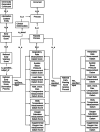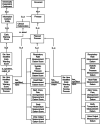Development and validation of the early warning system scores ontology
- PMID: 37730667
- PMCID: PMC10510162
- DOI: 10.1186/s13326-023-00296-6
Development and validation of the early warning system scores ontology
Abstract
Background: Clinical early warning scoring systems, have improved patient outcomes in a range of specializations and global contexts. These systems are used to predict patient deterioration. A multitude of patient-level physiological decompensation data has been made available through the widespread integration of early warning scoring systems within EHRs across national and international health care organizations. These data can be used to promote secondary research. The diversity of early warning scoring systems and various EHR systems is one barrier to secondary analysis of early warning score data. Given that early warning score parameters are varied, this makes it difficult to query across providers and EHR systems. Moreover, mapping and merging the parameters is challenging. We develop and validate the Early Warning System Scores Ontology (EWSSO), representing three commonly used early warning scores: the National Early Warning Score (NEWS), the six-item modified Early Warning Score (MEWS), and the quick Sequential Organ Failure Assessment (qSOFA) to overcome these problems.
Methods: We apply the Software Development Lifecycle Framework-conceived by Winston Boyce in 1970-to model the activities involved in organizing, producing, and evaluating the EWSSO. We also follow OBO Foundry Principles and the principles of best practice for domain ontology design, terms, definitions, and classifications to meet BFO requirements for ontology building.
Results: We developed twenty-nine new classes, reused four classes and four object properties to create the EWSSO. When we queried the data our ontology-based process could differentiate between necessary and unnecessary features for score calculation 100% of the time. Further, our process applied the proper temperature conversions for the early warning score calculator 100% of the time.
Conclusions: Using synthetic datasets, we demonstrate the EWSSO can be used to generate and query health system data on vital signs and provide input to calculate the NEWS, six-item MEWS, and qSOFA. Future work includes extending the EWSSO by introducing additional early warning scores for adult and pediatric patient populations and creating patient profiles that contain clinical, demographic, and outcomes data regarding the patient.
Keywords: Biomedical ontology; Early warning scores; Track; Trigger systems.
© 2023. BioMed Central Ltd., part of Springer Nature.
Conflict of interest statement
The authors declare no competing interests.
Figures





Similar articles
-
Quick Sequential Organ Failure Assessment Score and the Modified Early Warning Score for Predicting Clinical Deterioration in General Ward Patients Regardless of Suspected Infection.J Korean Med Sci. 2022 Apr 25;37(16):e122. doi: 10.3346/jkms.2022.37.e122. J Korean Med Sci. 2022. PMID: 35470597 Free PMC article.
-
The role of the quick sequential organ failure assessment score (qSOFA) and modified early warning score (MEWS) in the pre-hospitalization prediction of sepsis prognosis.Am J Emerg Med. 2021 Mar;41:158-162. doi: 10.1016/j.ajem.2020.09.049. Epub 2020 Sep 30. Am J Emerg Med. 2021. PMID: 33071081
-
[Comparison of four early warning scores in predicting the prognosis of critically ill patients in secondary hospitals].Zhonghua Wei Zhong Bing Ji Jiu Yi Xue. 2023 Oct;35(10):1093-1098. doi: 10.3760/cma.j.cn121430-20230614-00441. Zhonghua Wei Zhong Bing Ji Jiu Yi Xue. 2023. PMID: 37873716 Chinese.
-
Comparison of qSOFA and Hospital Early Warning Scores for prognosis in suspected sepsis in emergency department patients: a systematic review.Emerg Med J. 2022 Apr;39(4):284-294. doi: 10.1136/emermed-2020-210416. Epub 2021 Aug 17. Emerg Med J. 2022. PMID: 34404680
-
A review of early warning systems for prompt detection of patients at risk for clinical decline.J Trauma Acute Care Surg. 2019 Jul;87(1S Suppl 1):S67-S73. doi: 10.1097/TA.0000000000002197. J Trauma Acute Care Surg. 2019. PMID: 31246909 Review.
References
-
- McGaughey J, Alderdice F, Fowler R, Kapila A, Mayhew A, Moutray M. “Outreach and Early Warning Systems (EWS) for the prevention of intensive care admission and death of critically ill adult patients on general hospital wards,” Cochrane Database Syst Rev 2007(3);CD005529. 10.1002/14651858.CD005529.pub2. - PubMed
-
- Buist MD, Burton PR, Bernard SA, Waxman BP, Anderson J. Recognising clinical instability in hospital patients before cardiac arrest or unplanned admission to intensive care: a pilot study in a tertiary-care hospital. Med J Aust. 1999;171(1):22–25. doi: 10.5694/j.1326-5377.1999.tb123492.x. - DOI - PubMed
MeSH terms
LinkOut - more resources
Full Text Sources

